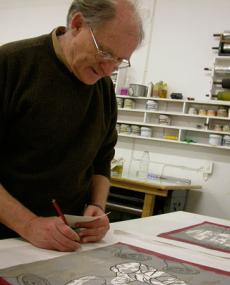
Paul Stopforth Image source
“Drawing is one way of articulating my relationship to the world.”
Paul Stopforth is a painter and graphic artist who works in oil, gouache, ink, charcoal, metal, encaustic processes and lithography. He was born in 1945 in Johannesburg, South Africa. From the age of 19 he studied at the NATD, Johannesburg College of Art, where he graduated in 1967.
After having lectured in Fine Art at the Natal Technical College in Durban from 1968 to 1971, he was a part-time lecturer in Fine Arts at the University of Pretoria till 1978. That year he returned to Johannesburg and taught painting and drawing at The University of the Witwatersrand for 8 years. In 1977, along Wolf Weineck and Gavin Younge, he founded and the Market Theatre Gallery which he directed for the next seven years.
Inspired by the death of Black Consciousness leader Steve Biko in 1978, the artist created one of his most recognised works of art: The Interrogators. This renowned triptych details the portraits of the security officers who interrogated Biko. Stopforth intended to portray “terribly ordinary-looking” people as the torturers of Biko to represent the commonality in these happenings - what he called the “banality of evil”.
The Interrogators was continued by a series of 20 drawings based on the death of Biko. His works around this time give evidence to a kind of witnessing and testimony in relation to apartheid-era interrogation and torture, and to the deaths in detention to which these practices led (figure 2). They constitute one of the great works of art produced in protest to the apartheid regime. In relation to the struggle, Stopforth remarked, “I want to bring the facts home to those willing to look. My figures parallel something that we can’t be witness to. We can’t refuse to accept that these things happen.”
Stopforth continued to express the situation of politically involved human beings. In 1984, he obtained a British Council Scholarship to study in the United Kingdom. Starting in 1985, he engaged in a one-year postgraduate study at the Royal College of Art in London. Disappointed by the continuous build up of tension and oppression in South Africa and believing nothing would alter the realities of racism and human rights abuses, Stopforth moved to the United States in 1988.
His exile led him to a path of introspection, where he understood the negative influence that the apartheid regime had upon his own life and suffering, a control that was hidden behind the benefits bestowed on white South Africans. It was by leaving the country that he realized that the apartheid regime actively prevented him from confronting his own suffering. He gained perspective and understanding. Now, he reflects, “I engage with history, with memory; I hover between two places, which is a way of forming insight.”
Stopforth became Lecturer on Visual and Environmental Studies and Director of Undergraduate Studies at Harvard University in 1996. He recently retired and is a full time visiting faculty member at the School of the Museum of Fine Arts, Boston.
Stopforth has always maintained interest in South African issues. In 2003 he was invited to Robben Island as a resident artist. There he made works from fragments of various objects and memories on the island, for example Madiba’s blanket and a loudspeaker he found on the island. “The things I found on the island embody the sacrifices made by the men and women who fought against Apartheid,” said Stopforth. This body of work was shown in a group exhibition in November 2006 at the Mandela Gateway in the Western Cape.
Paul Stopforth has been the recipient of various awards amongst which are: the Student Representative Council Award for Best Student in 1967, the Institute of Race Relations Award in 1971, The Rodney Burn Award for Figurative Drawing by the Royal College of Art in 1985, and the Ian Haggie Award for Best Artist in 1986. He has held exhibitions in South Africa, Europe and The United States.
Public collections holding his works include the Harvard Film Archive; the Constitutional Court of South Africa; Tufts University Gallery; the National Gallery, Cape Town; Johannesburg Art Gallery; Durban Art Museum; the Pretoria Art Gallery; and University of the Witwatersrand Art Galleries. He is currently represented by David Krut Projects in New York.
For a complete CV of Paul Stopforth’s education, awards, exhibitions and collections please visit http://www.paulstopforth.com/resume.htm


